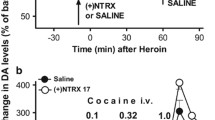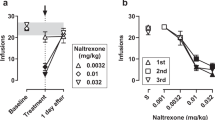Abstract
Rationale
In humans, μ opioid–cocaine combinations (speedballs) have been reported to heighten pleasurable effects and result in greater abuse potential compared to either drug individually. Emerging evidence in animals suggests that the ability of μ opioids to enhance the reinforcing effects of cocaine might be independent of their μ intrinsic efficacy even though μ agonist efficacy appears to be a determinant in the reinforcing effects of μ opioids themselves.
Objectives
This study examined the relationship between agonist efficacy, self-administration, and the enhancement of cocaine self-administration using the high-efficacy μ agonist etonitazene.
Materials and methods
Rhesus monkeys self-administered cocaine, heroin, etonitazene, and opioid–cocaine combinations under a progressive-ratio schedule of intravenous drug injection.
Results
Unlike cocaine and heroin, etonitazene did not maintain consistent self-administration at any dose tested (0.001–1.0 μg/kg/injection). However, combining etonitazene (0.1–1.0 μg/kg/injection) with cocaine (0.01 and 0.03 mg/kg/injection) enhanced cocaine self-administration, and this enhancement was attenuated by naltrexone. These effects are similar to those obtained by combining non-reinforcing doses of heroin and cocaine. Antagonism of etonitazene–cocaine and heroin–cocaine self-administration by naloxonazine was short lasting and was not maintained after 24 h (when naloxonazine’s purported μ1 subtype antagonist effects are thought to predominate).
Conclusions
The results suggest that high μ agonist efficacy does not guarantee consistent drug self-administration and that the ability of μ agonists to enhance cocaine self-administration does not depend exclusively on reinforcing efficacy. Moreover, the results do not support a major role for μ1 receptor mechanisms in either etonitazene- or heroin-induced enhancement of cocaine self-administration.





Similar content being viewed by others
References
Ahlgren-Beckendorf JA, Stewart RB, Gomez TH, Silverman PB, Meisch RA (1998) Lever-press responding maintained by contingent intraperitoneal administration of etonitazene in Long Evans hooded rats. J Neurosci Methods 80:149–154
Braida D, Virag W, Ottonello F, Inghilterra S, Gori E, Sala M (1998) A novel method for self-administering addicting drugs intracerebroventricularly in a free-choice procedure. Brain Res Brain Res Protoc 3:135–141
Butelman ER, France CP, Woods JH (1993) Apparent pA2 analysis on the respiratory depressant effects of alfentanil, etonitazene, ethylketocyclazocine (EKC) and Mr2033 in rhesus monkeys. J Pharmacol Exp Ther 264:145–151
Carroll ME, Meisch RA (1978) Etonitazene as a reinforcer: oral intake of etonitazene by rhesus monkeys. Psychopharmacology (Berl) 59:225–229
Carroll ME, France CP, Meisch RA (1979) Food deprivation increases oral and intravenous drug intake in rats. Science 205:319–321
Carroll ME, Pederson MC, Harrison RG (1986) Food deprivation reveals strain differences in opiate intake of Sprague–Dawley and Wistar rats. Pharmacol Biochem Behav 24:1095–1099
Emmerson PJ, Liu MR, Woods JH, Medzihradsky F (1994) Binding affinity and selectivity of opioids at mu, delta and kappa receptors in monkey brain membranes. J Pharmacol Exp Ther 271:1630–1637
Emmerson PJ, Clark MJ, Mansour A, Akil H, Woods JH, Medzihradsky F (1996) Characterization of opioid agonist efficacy in a C6 glioma cell line expressing the mu opioid receptor. J Pharmacol Exp Ther 278:1121–1127
Foltin RW, Fischman MW (1994) Effects of buprenorphine on the self-administration of cocaine by humans. Behav Pharmacol 5:79–89
Gatch MB, Liguori A, Negus SS, Mello NK, Bergman J (1996) Naloxonazine antagonism of levorphanol-induced antinociception and respiratory depression in rhesus monkeys. Eur J Pharmacol 298:31–36
Gerak LR, Butelman ER, Woods JH, France CP (1994) Antinociceptive and respiratory effects of nalbuphine in rhesus monkeys. J Pharmacol Exp Ther 271:993–999
Grecksch G, Bartzsch K, Widera A, Becker A, Höllt V, Koch T (2006) Development of tolerance and sensitization to different opioid agonists in rats. Psychopharmacology (Berl) 186:177–184
Kishioka S, Ko MC, Woods JH (2000) Diltiazem enhances the analgesic but not the respiratory depressant effects of morphine in rhesus monkeys. Eur J Pharmacol 397:85–92
Koch T, Widera A, Bartzsch K, Schulz S, Brandenburg LO, Wundrack N, Beyer A, Grecksch G, Höllt V (2005) Receptor endocytosis counteracts the development of opioid tolerance. Mol Pharmacol 67:280–287
Ling GS, Spiegel K, Lockhart SH, Pasternak GW (1985) Separation of opioid analgesia from respiratory depression: evidence for different receptor mechanisms. J Pharmacol Exp Ther 232:149–155
McMillan DE, Leander JD (1976) Schedule-induced oral self administration of etonitazene. Pharmacol Biochem Behav 4:137–141
Meisch RA (1995) Oral self-administration of etonitazene in rhesus monkeys: use of a fading procedure to establish etonitazene as a reinforcer. Pharmacol Biochem Behav 50:571–580
Meisch RA, Kliner DJ (1979) Etonitazene as a reinforcer for rats: increased etonitazene-reinforced behavior due to food deprivation. Psychopharmacology (Berl) 63:97–98
Mello NK, Lukas SE, Bree MP, Mendelson JH (1988) Progressive ratio performance maintained by buprenorphine, heroin and methadone in Macaque monkeys. Drug Alcohol Depend 21:81–97
Moolten MS, Fishman JB, Chen JC, Carlson KR (1993) Etonitazene: an opioid selective for the mu receptor types. Life Sci 52:PL199–203
Negus SS, Henriksen SJ, Mattox A, Pasternak GW, Portoghese PS, Takemori AE, Weinger MB, Koob GF (1993) Effect of antagonists selective for mu, delta and kappa opioid receptors on the reinforcing effects of heroin in rats. J Pharmacol Exp Ther 265:1245–1252
Piepponen TP, Kivastik T, Katajamäki J, Zharkovsky A, Ahtee L (1997) Involvement of opioid mu 1 receptors in morphine-induced conditioned place preference in rats. Pharmacol Biochem Behav 58:275–279
Platt DM, Carey G, Spealman RD (2005) Intravenous self-administration techniques in monkeys. In: Crawley J, Gerfen C, Rogawski M, Sibley D, Skolnick P, Wray S (eds) Current protocols in neuroscience. Wiley, Hoboken, NJ, pp 9.21.1–9.21.15
Rowlett JK, Massey BW, Kleven MS, Woolverton WL (1996) Parametric analysis of cocaine self-administration under a progressive-ratio schedule in rhesus monkeys. Psychopharmacology (Berl) 125:361–370
Rowlett JK, Wilcox KM, Woolverton WL (1998) Self-administration of cocaine-heroin combinations by rhesus monkeys: antagonism by naltrexone. J Pharmacol Exp Ther 286:61–69
Rowlett JK, Rodefer JS, Spealman RD (2002) Self-administration of cocaine, alfentanil, and nalbuphine under progressive-ratio schedules: consumer demand and labor supply analyses of relative reinforcing effectiveness. Exp Clin Psychopharmacol 10:367–375
Rowlett JK, Rodefer JS, Spealman RD (2005) Self-Administration of cocaine-opioid combinations by rhesus monkeys: evaluation of the role of mu receptor efficacy using labor supply analysis. J Pharmacol Exp Ther 312:1289–1297
Suzuki T, George FR, Meisch RA (1992) Etonitazene delivered orally serves as a reinforcer for Lewis but not Fischer 344 rats. Pharmacol Biochem Behav 42:579–586
Suzuki T, Mori T, Tsuji M, Misawa M, Nagase H (1995) Discriminative stimulus properties of morphine mediated by mu 1-opioid receptors. Eur J Pharmacol 284:195–198
Vanderschuren LJ, Kalivas PW (2000) Alterations in dopaminergic and glutamatergic transmission in the induction and expression of behavioral sensitization: a critical review of preclinical studies. Psychopharmacology (Berl) 151:99–120
Walker EA, Butelman ER, DeCosta BR, Woods JH (1993) Opioid thermal antinociception in rhesus monkeys: receptor mechanisms and temperature dependency. J Pharmacol Exp Ther 267:280–286
Walker EA, Zernig G, Woods JH (1995) Buprenorphine antagonism of mu opioids in the rhesus monkey tail-withdrawal procedure. J Pharmacol Exp Ther 273:1345–1352
Walsh SL, Sullivan JT, Preston KL, Garner JE, Bigelow GE (1996) Effects of naltrexone on response to intravenous cocaine, hydromorphone and their combination in humans. J Pharmacol Exp Ther 279:524–538
Winger G, Woods JH, Hursh SR (1996) Behavior maintained by alfentanil or nalbuphine in rhesus monkeys: Fixed-ratio and time-out changes to establish demand curves and relative reinforcing effectiveness. Exp Clin Psychopharmacol 4:131–140
Zernig G, Lewis JW, Woods JH (1997) Clocinnamox inhibits the intravenous self-administration of opioid agonists in rhesus monkeys: comparison with effects on opioid agonist-mediated antinociception. Psychopharmacology (Berl) 129:233–242
Acknowledgments
We thank Laura Teixeira and Annemarie Duggan for their expert technical assistance and Donna Reed for editorial assistance. We also acknowledge NIDA for providing a generous gift of Heroin HCl. The work was supported by United States Public Health Service Grants DA11928 and RR00168.
Author information
Authors and Affiliations
Corresponding author
Rights and permissions
About this article
Cite this article
Achat-Mendes, C., Valdez, G.R., Platt, D.M. et al. Intravenous self-administration of etonitazene alone and combined with cocaine in rhesus monkeys: comparison with heroin and antagonism by naltrexone and naloxonazine. Psychopharmacology 204, 489–498 (2009). https://doi.org/10.1007/s00213-009-1480-0
Received:
Accepted:
Published:
Issue Date:
DOI: https://doi.org/10.1007/s00213-009-1480-0




